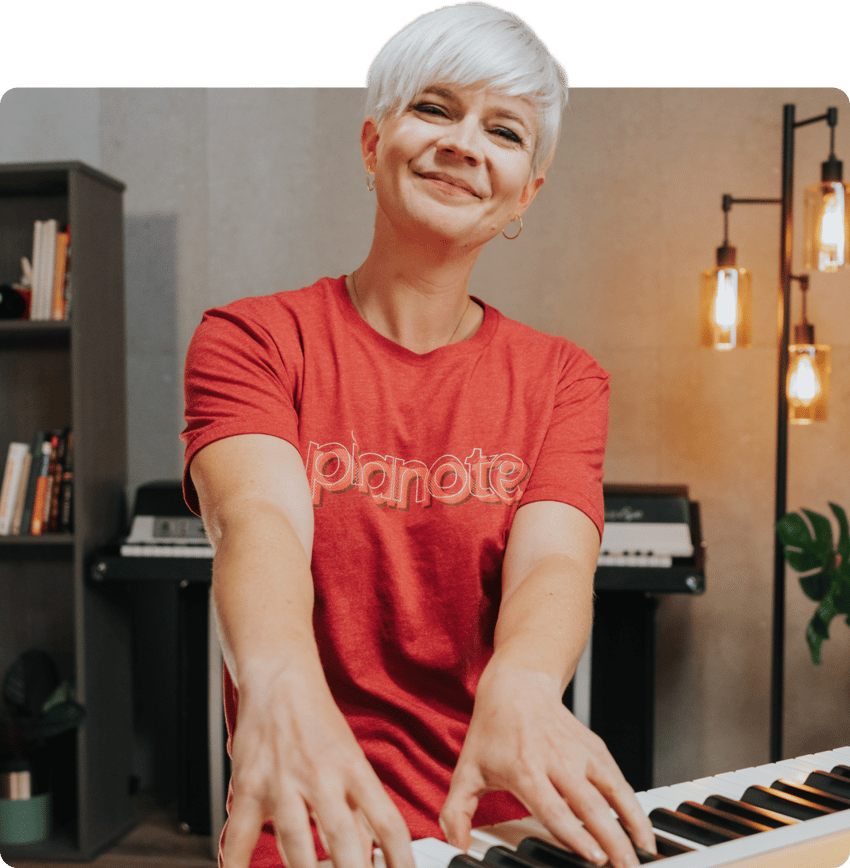Perfect posture at the piano is super important. But many piano players (especially beginners) don’t know how to sit at the piano correctly.
This leads to bad posture, which can cause strain and make you feel tired.
At its worst, it can lead to injury and stop you from playing the piano altogether!
So let’s fix that.
Get exclusive interviews, fascinating articles, and inspiring lessons delivered straight to your inbox.
This is the comprehensive guide to perfect posture at the piano, from an expert.
Dr. Sean Kilgannon is a chiropractor in British Columbia. He’s actually MY chiropractor. I see him because I have issues with my forearms, which you’ll hear about in the lesson.
Dr. Kilgannon is also a musician! So he knows the needs of piano players and has so much fantastic advice to help you sit correctly and comfortably, so you can play pain-free.
Most of us live our lives hunched.
How’s your posture right now? If you’re at a computer, are you hunching forward? Or if you’re reading this on your phone, are you hunching over the screen?
This hunching translates to the piano.
We sit with our back rounded, like this:
By sitting like that, our pelvis tilts back, rounding the lower spine. That’s not great.
Dr. Kilgannon says the pelvis should be in a neutral position.
So for me, that involves consciously tilting it forward a little bit to get it to where it should be.
This also creates a slight curve in the lower back and helps to align the spine.
”If we tuck the low back in … our spine stacks on the discs, and then we’re not hanging on the ligaments” ~ Dr. Kilgannon
And when you do sit up tall, you don’t want to “jerk” your shoulders back too much. Dr. Kilgannon says that will just tire out the muscles in the upper back.
Elbows and wrists are common issues for piano players.
We need to use our arms and we often twist at the wrist, especially when playing thumb tucks for arpeggios.
This puts strain on our forearms which can lead to issues (like the ones I see Dr. Kigannon about).
To combat this, it helps to do some strength training, and it’s super important to stretch!
Which brings us to the need to…
Warming up to play the piano is NOT just about playing scales, Hanon exercises, or arpeggios.
It’s also about warming-up our bodies to be ready for the physical aspect of playing.
If you do yoga, it can be really beneficial to do a quick, 10-minute session before sitting at the keys. But let’s be honest, most of us probably don’t!
Even just some simple stretching exercises before you play will make a big difference over the long run.
So let’s look at some.
To stretch the forearm, lock your elbow, bring your hand down and use your other hand to stretch that forearm out:
Then reverse the stretch and bring your hand back up:
This should only take a couple of minutes. The goal is to warm-up, not tire-out!
With all the hunching we do in our daily lives, our neck and shoulders can carry a lot of tension.
Here are some great stretches Dr. Kilgannon showed me.
First, sit tall on your chair and hold the sides of the chair with your hands. Then lean to one side and really feel the stretch in the side of your neck:
It feels so good!!
Then, grab the back corner of your piano bench (or chair). Put your hand on your head and stretch forward at a 45-degree angle, opposite to where you’re holding the chair:
And finally, while sitting up straight let your head stretch forward.
The video has SO much more great advice from Dr. Kigannon, including tips for a healthy diet.
He also talks about how to play the piano if you suffer from arthritis or even if you have some old injuries that are causing pain.
I strongly recommend you watch the entire thing.
But the ONE thing to take away from this is that perfect posture at the piano is SO important.
Pay attention to how you’re sitting and try some stretches. Looking after your posture will guarantee that you can play the piano pain-free and for years to come.
Have fun and happy practicing (with proper posture at the piano)!
Subscribe to The Note for exclusive interviews, fascinating articles, and inspiring lessons delivered straight to your inbox. Unsubscribe at any time.
Lisa Witt has been teaching piano for more than 20 years and in that time has helped hundreds of students learn to play the songs they love. Lisa received classical piano training through the Royal Conservatory of Music, but she has since embraced popular music and playing by ear in order to accompany herself and others. Learn more about Lisa.


By signing up you’ll also receive our ongoing free lessons and special offers. Don’t worry, we value your privacy and you can unsubscribe at any time.
We use cookies for traffic data and advertising. Cookie Policy »